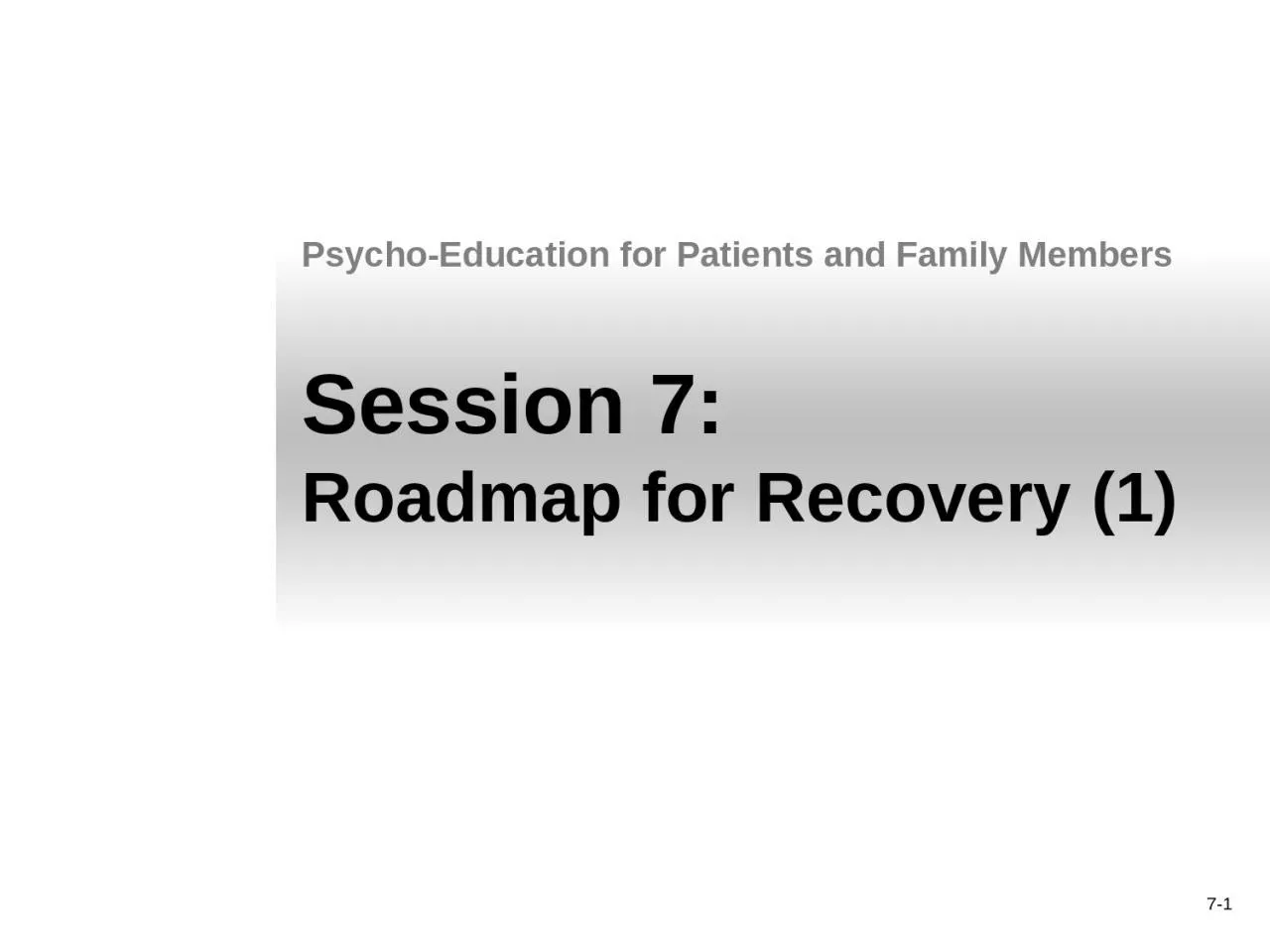

PsychoEducation for Patients and Family Members Recovery Stages Stage 1 Withdrawal 12 weeks Stage 2 Early Abstinence or Honeymoon following 1 month Stage 3 Protracted Abstinence or the Wall ID: 930098
Download Presentation The PPT/PDF document "7- 1 Session 7: Roadmap for Recovery (1)" is the property of its rightful owner. Permission is granted to download and print the materials on this web site for personal, non-commercial use only, and to display it on your personal computer provided you do not modify the materials and that you retain all copyright notices contained in the materials. By downloading content from our website, you accept the terms of this agreement.
Slide1
7-1
Session 7:Roadmap for Recovery (1)
Psycho-Education for Patients and Family Members
Slide2Recovery Stages
Stage 1: Withdrawal (1-2 weeks)Stage 2: Early Abstinence or “Honeymoon”(following 1 month) Stage 3: Protracted Abstinence or “the Wall”(following 3-4 months)Stage 4: Adjustment/Resolution(following 2 months)7-2
Slide3Question:
After stopping substance use, how have your feelings and physical conditions changed over time?1-3
Slide4Stage 1: Withdrawal (1-2 weeks)
Physical detoxificationCravingsDepression/anxietyLow energyIrritabilityExhaustionInsomniaParanoiaMemory problemsIntense hunger7-4
Characteristics
Slide5Stage 1: Withdrawal (1-2 weeks)
Powerful cravingsParanoiaDepressionFear of withdrawal symptomsDisordered sleep patternsUnstructured timeProximity of triggers7-5Relapse Risk Factors (for those in outpatient treatment)
Slide6Stage 2: Early Abstinence or “Honeymoon” (following 1 month)
Increased energy and optimism Overconfidence Difficulty concentratingContinued memory problemsConcern about weight gainIntense feelingsMood swingsOther substance useInability to prioritizeMild paranoia7-6Characteristics
Slide7Tiredness and stress due to “Workaholism”Discontinuation of structure (including treatment)Overconfidence
Secondary drug or alcohol useResistance to behavior change7-7Relapse Risk Factors (for those in outpatient treatment)Stage 2: Early Abstinence or “Honeymoon” (following 1 month)
Slide8Stage 3: Protracted Abstinence or “the Wall” (following 3-4 months)
Low energyReturn of cravingsReturn to old behaviorsContinued lifestyle changesPositive benefits from abstinenceAnger and depressionEmotional swingsParanoia or suspicionUnclear thinkingIsolationWeight gainFamily adjustment and conflict8-8Characteristics
Slide9Increased emotionalityBreakdown of structureBehavioral “drift”
Interpersonal conflictDecreased ability to feel pleasureLoss of motivationInsomniaLow energy/fatigueParanoiaSecondary drug useRelapse justification8-9
Stage 3: Protracted Abstinence or “the Wall”
(following 3-4 months)
Relapse Risk Factors (for those in outpatient treatment)
Slide10Stage 4: Adjustment and Resolution (following 2 months)
Feelings of accomplishmentContinued lifestyle and relationship change
People in this stage need to shift from learning new skills to:
Maintaining a balanced lifestyle
Monitoring for relapse signs
Accepting that recovery is a life-long process
Developing new areas of interest
8-
10
Characteristics
Slide11Secondary drug or alcohol useFeeling “cured” and relaxing vigilance for relapse signsRelaxation of structure
Return to relationships with people who use substancesNeglect recovery activities, losing the momentum of recoveryNeglect exercise and other self-care activities8-11
Stage 4: Adjustment and Resolution
(following 2 months)
Relapse Risk Factors
Slide12Necessary Lifestyle Balance
WorkSleepRecovery ActivitiesLeisureRelationships
8-
12
Stage 4: Adjustment and Resolution
(following 2 months)
Slide13Question:
Why is it important to have a structured lifestyle in the process of recovery?1-13
Slide14Structured Lifestyle
Self-designed structure:Helps eliminate avoidable triggersMakes the concept of “one day at a time” concreteReduces anxietyCounters the drug-using lifestyleProvides a basic foundation for ongoing recovery7-14
Slide15Building Blocks of Structure
Treatment Activities
Recreational/Leisure
Activities
12-Step/Self-Help Meetings
School
Sports
Activities With Friends
Who Are Drug Free
Activities With Friends Who Are Drug Free
Time Scheduling
Exercise
Exercise
Work
Family-Related Events
Community Activities
Spiritual Activities
Island Building
7-
15
Structured Lifestyle
Slide16Scheduling Pitfalls
Unrealistic schedulesUnbalanced schedulesImposed schedulesNo support from significant othersHolidays, illness, and other changes7-16
Structured Lifestyle